github.com/kaituanwang/hyperledger@v2.0.1+incompatible/docs/source/ledger/ledger.md (about) 1 # Ledger 2 3 **Audience**: Architects, Application and smart contract developers, 4 administrators 5 6 A **ledger** is a key concept in Hyperledger Fabric; it stores important factual 7 information about business objects; both the current value of the attributes of 8 the objects, and the history of transactions that resulted in these current 9 values. 10 11 In this topic, we're going to cover: 12 13 * [What is a Ledger?](#what-is-a-ledger?) 14 * [Storing facts about business objects](#ledgers-facts-and-states) 15 * [A blockchain ledger](#a-blockchain-ledger) 16 * [The world state](#world-state) 17 * [The blockchain data structure](#blockchain) 18 * [How blocks are stored in a blockchain](#blocks) 19 * [Transactions](#transactions) 20 * [World state database options](#world-state-database-options) 21 * [The **Fabcar** example ledger](#example-ledger-fabcar) 22 * [Ledgers and namespaces](#namespaces) 23 * [Ledgers and channels](#channels) 24 25 ## What is a Ledger? 26 27 A ledger contains the current state of a business as a journal of transactions. 28 The earliest European and Chinese ledgers date from almost 1000 years ago, and 29 the Sumerians had [stone 30 ledgers](http://www.sciencephoto.com/media/686227/view/accounting-ledger-sumerian-cuneiform) 31 4000 years ago -- but let's start with a more up-to-date example! 32 33 You're probably used to looking at your bank account. What's most important to 34 you is the available balance -- it's what you're able to spend at the current 35 moment in time. If you want to see how your balance was derived, then you can 36 look through the transaction credits and debits that determined it. This is a 37 real life example of a ledger -- a state (your bank balance), and a set of 38 ordered transactions (credits and debits) that determine it. Hyperledger Fabric 39 is motivated by these same two concerns -- to present the current value of a set 40 of ledger states, and to capture the history of the transactions that determined 41 these states. 42 43 ## Ledgers, Facts and States 44 45 A ledger doesn't literally store business objects -- instead it stores **facts** 46 about those objects. When we say "we store a business object in a ledger" what 47 we really mean is that we're recording the facts about the current state of an 48 object, and the facts about the history of transactions that led to the current 49 state. In an increasingly digital world, it can feel like we're looking at an 50 object, rather than facts about an object. In the case of a digital object, it's 51 likely that it lives in an external datastore; the facts we store in the ledger 52 allow us to identify its location along with other key information about it. 53 54 While the facts about the current state of a business object may change, the 55 history of facts about it is **immutable**, it can be added to, but it cannot be 56 retrospectively changed. We're going to see how thinking of a blockchain as an 57 immutable history of facts about business objects is a simple yet powerful way 58 to understand it. 59 60 Let's now take a closer look at the Hyperledger Fabric ledger structure! 61 62 63 ## The Ledger 64 65 In Hyperledger Fabric, a ledger consists of two distinct, though related, parts 66 -- a world state and a blockchain. Each of these represents a set of facts about 67 a set of business objects. 68 69 Firstly, there's a **world state** -- a database that holds **current values** 70 of a set of ledger states. The world state makes it easy for a program to directly 71 access the current value of a state rather than having to calculate it by traversing 72 the entire transaction log. Ledger states are, by default, expressed as **key-value** pairs, 73 and we'll see later how Hyperledger Fabric provides flexibility in this regard. 74 The world state can change frequently, as states can be created, updated and deleted. 75 76 Secondly, there's a **blockchain** -- a transaction log that records all the 77 changes that have resulted in the current the world state. Transactions are 78 collected inside blocks that are appended to the blockchain -- enabling you to 79 understand the history of changes that have resulted in the current world state. 80 The blockchain data structure is very different to the world state because once 81 written, it cannot be modified; it is **immutable**. 82 83  *A Ledger L comprises blockchain B and 84 world state W, where blockchain B determines world state W. We can also say that 85 world state W is derived from blockchain B.* 86 87 It's helpful to think of there being one **logical** ledger in a Hyperledger 88 Fabric network. In reality, the network maintains multiple copies of a ledger -- 89 which are kept consistent with every other copy through a process called 90 **consensus**. The term **Distributed Ledger Technology** (**DLT**) is often 91 associated with this kind of ledger -- one that is logically singular, but has 92 many consistent copies distributed throughout a network. 93 94 Let's now examine the world state and blockchain data structures in more detail. 95 96 ## World State 97 98 The world state holds the current value of the attributes of a business object 99 as a unique ledger state. That's useful because programs usually require the 100 current value of an object; it would be cumbersome to traverse the entire 101 blockchain to calculate an object's current value -- you just get it directly 102 from the world state. 103 104 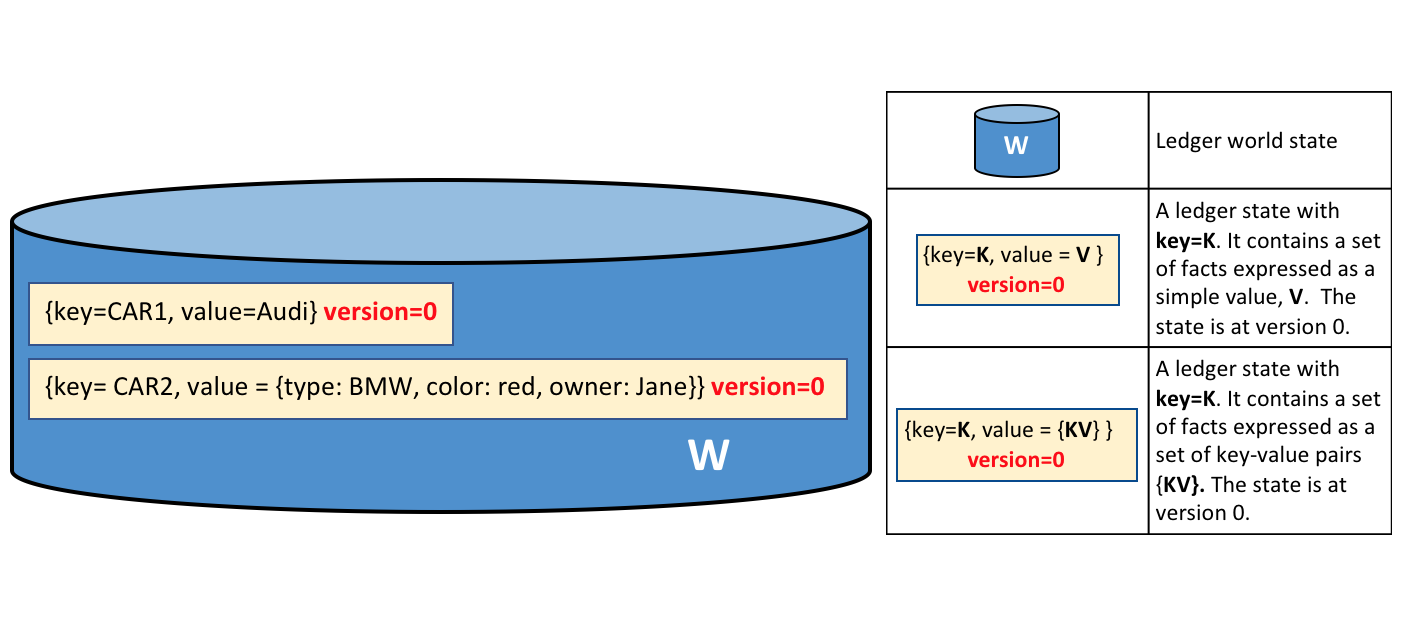 *A ledger world state containing 105 two states. The first state is: key=CAR1 and value=Audi. The second state has a 106 more complex value: key=CAR2 and value={model:BMW, color=red, owner=Jane}. Both 107 states are at version 0.* 108 109 A ledger state records a set of facts about a particular business object. Our 110 example shows ledger states for two cars, CAR1 and CAR2, each having a key and a 111 value. An application program can invoke a smart contract which uses simple 112 ledger APIs to **get**, **put** and **delete** states. Notice how a state value 113 can be simple (Audi...) or compound (type:BMW...). The world state is often 114 queried to retrieve objects with certain attributes, for example to find all red 115 BMWs. 116 117 The world state is implemented as a database. This makes a lot of sense because 118 a database provides a rich set of operators for the efficient storage and 119 retrieval of states. We'll see later that Hyperledger Fabric can be configured 120 to use different world state databases to address the needs of different types 121 of state values and the access patterns required by applications, for example in 122 complex queries. 123 124 Applications submit transactions which capture changes to the world state, and 125 these transactions end up being committed to the ledger blockchain. Applications 126 are insulated from the details of this [consensus](../txflow.html) mechanism by 127 the Hyperledger Fabric SDK; they merely invoke a smart contract, and are 128 notified when the transaction has been included in the blockchain (whether valid 129 or invalid). The key design point is that only transactions that are **signed** 130 by the required set of **endorsing organizations** will result in an update to 131 the world state. If a transaction is not signed by sufficient endorsers, it will 132 not result in a change of world state. You can read more about how applications 133 use [smart contracts](../smartcontract/smartcontract.html), and how to [develop 134 applications](../developapps/developing_applications.html). 135 136 You'll also notice that a state has a version number, and in the diagram above, 137 states CAR1 and CAR2 are at their starting versions, 0. The version number is for 138 internal use by Hyperledger Fabric, and is incremented every time the state 139 changes. The version is checked whenever the state is updated to make sure the 140 current states matches the version at the time of endorsement. This ensures that 141 the world state is changing as expected; that there has not been a concurrent 142 update. 143 144 Finally, when a ledger is first created, the world state is empty. Because any 145 transaction which represents a valid change to world state is recorded on the 146 blockchain, it means that the world state can be re-generated from the 147 blockchain at any time. This can be very convenient -- for example, the world 148 state is automatically generated when a peer is created. Moreover, if a peer 149 fails abnormally, the world state can be regenerated on peer restart, before 150 transactions are accepted. 151 152 ## Blockchain 153 154 Let's now turn our attention from the world state to the blockchain. Whereas the 155 world state contains a set of facts relating to the current state of a set of 156 business objects, the blockchain is an historical record of the facts about how 157 these objects arrived at their current states. The blockchain has recorded every 158 previous version of each ledger state and how it has been changed. 159 160 The blockchain is structured as sequential log of interlinked blocks, where each 161 block contains a sequence of transactions, each transaction representing a query 162 or update to the world state. The exact mechanism by which transactions are 163 ordered is discussed [elsewhere](../peers/peers.html#peers-and-orderers); 164 what's important is that block sequencing, as well as transaction sequencing 165 within blocks, is established when blocks are first created by a Hyperledger 166 Fabric component called the **ordering service**. 167 168 Each block's header includes a hash of the block's transactions, as well a hash 169 of the prior block's header. In this way, all transactions on the ledger are sequenced 170 and cryptographically linked together. This hashing and linking makes the ledger data 171 very secure. Even if one node hosting the ledger was tampered with, it would not be able to 172 convince all the other nodes that it has the 'correct' blockchain because the ledger is 173 distributed throughout a network of independent nodes. 174 175 The blockchain is always implemented as a file, in contrast to the world state, 176 which uses a database. This is a sensible design choice as the blockchain data 177 structure is heavily biased towards a very small set of simple operations. 178 Appending to the end of the blockchain is the primary operation, and query is 179 currently a relatively infrequent operation. 180 181 Let's have a look at the structure of a blockchain in a little more detail. 182 183 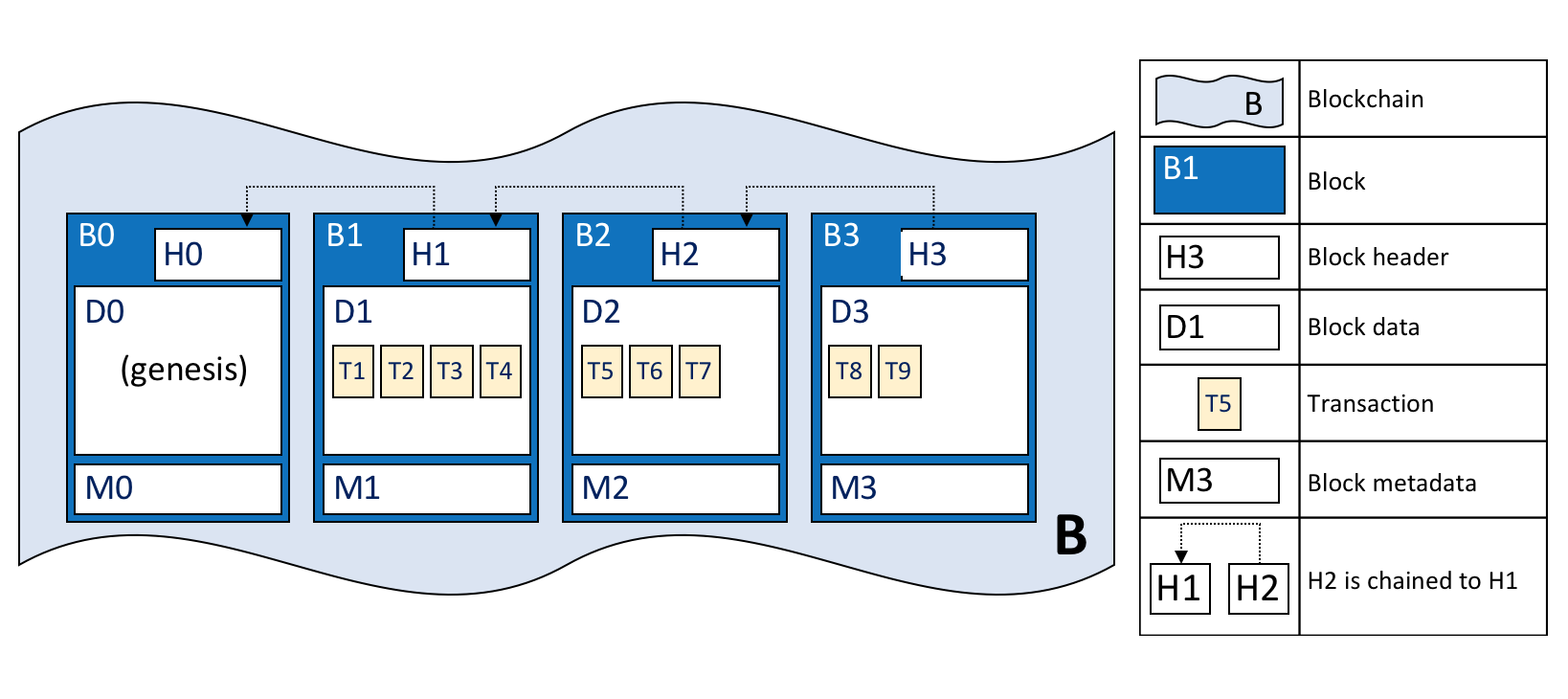 *A blockchain B containing blocks 184 B0, B1, B2, B3. B0 is the first block in the blockchain, the genesis block.* 185 186 In the above diagram, we can see that **block** B2 has a **block data** D2 which 187 contains all its transactions: T5, T6, T7. 188 189 Most importantly, B2 has a **block header** H2, which contains a cryptographic 190 **hash** of all the transactions in D2 as well as a hash of H1. In this way, 191 blocks are inextricably and immutably linked to each other, which the term **blockchain** 192 so neatly captures! 193 194 Finally, as you can see in the diagram, the first block in the blockchain is 195 called the **genesis block**. It's the starting point for the ledger, though it 196 does not contain any user transactions. Instead, it contains a configuration 197 transaction containing the initial state of the network channel (not shown). We 198 discuss the genesis block in more detail when we discuss the blockchain network 199 and [channels](../channels.html) in the documentation. 200 201 ## Blocks 202 203 Let's have a closer look at the structure of a block. It consists of three 204 sections 205 206 * **Block Header** 207 208 This section comprises three fields, written when a block is created. 209 210 * **Block number**: An integer starting at 0 (the genesis block), and 211 increased by 1 for every new block appended to the blockchain. 212 213 * **Current Block Hash**: The hash of all the transactions contained in the 214 current block. 215 216 * **Previous Block Header Hash**: The hash from the previous block header. 217 218 These fields are internally derived by cryptographically hashing the block 219 data. They ensure that each and every block is inextricably linked to its 220 neighbour, leading to an immutable ledger. 221 222 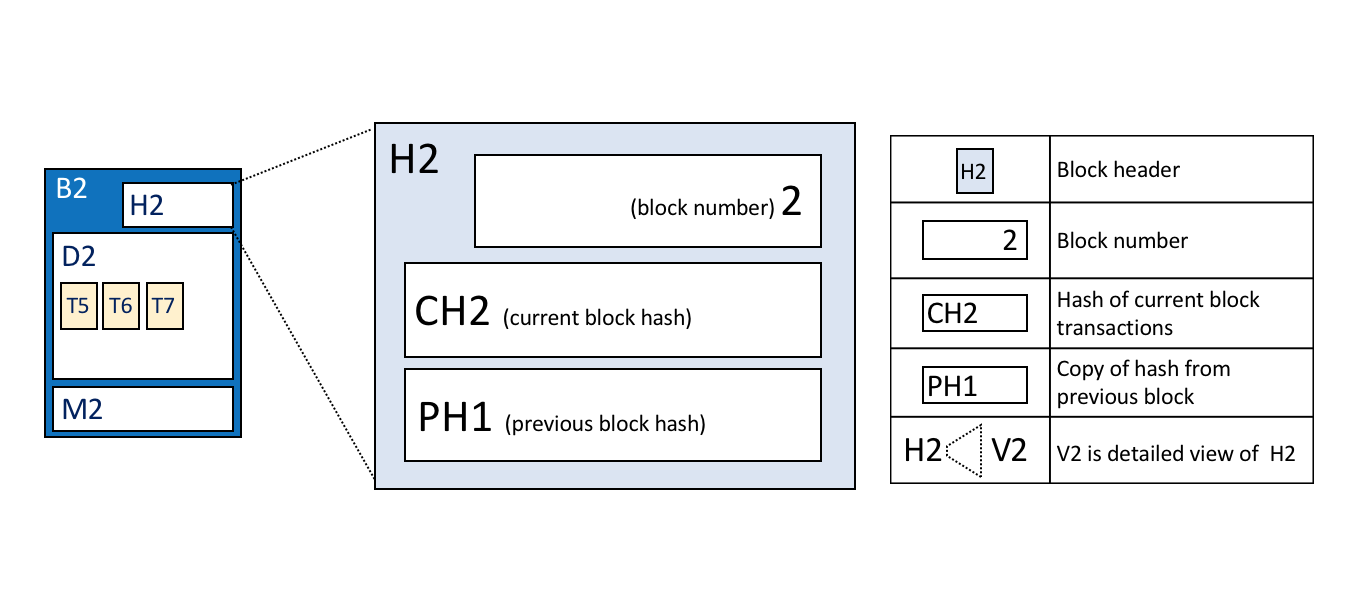 *Block header details. The header H2 223 of block B2 consists of block number 2, the hash CH2 of the current block data 224 D2, and the hash of the prior block header H1.* 225 226 227 * **Block Data** 228 229 This section contains a list of transactions arranged in order. It is written 230 when the block is created by the ordering service. These transactions have a 231 rich but straightforward structure, which we describe [later](#Transactions) 232 in this topic. 233 234 235 * **Block Metadata** 236 237 This section contains the certificate and signature of the block creator which is used to verify 238 the block by network nodes. 239 Subsequently, the block committer adds a valid/invalid indicator for every transaction into 240 a bitmap that also resides in the block metadata, as well as a hash of the cumulative state updates 241 up until and including that block, in order to detect a state fork. 242 Unlike the block data and header fields, this section is not an input to the block hash computation. 243 244 245 ## Transactions 246 247 As we've seen, a transaction captures changes to the world state. Let's have a 248 look at the detailed **blockdata** structure which contains the transactions in 249 a block. 250 251 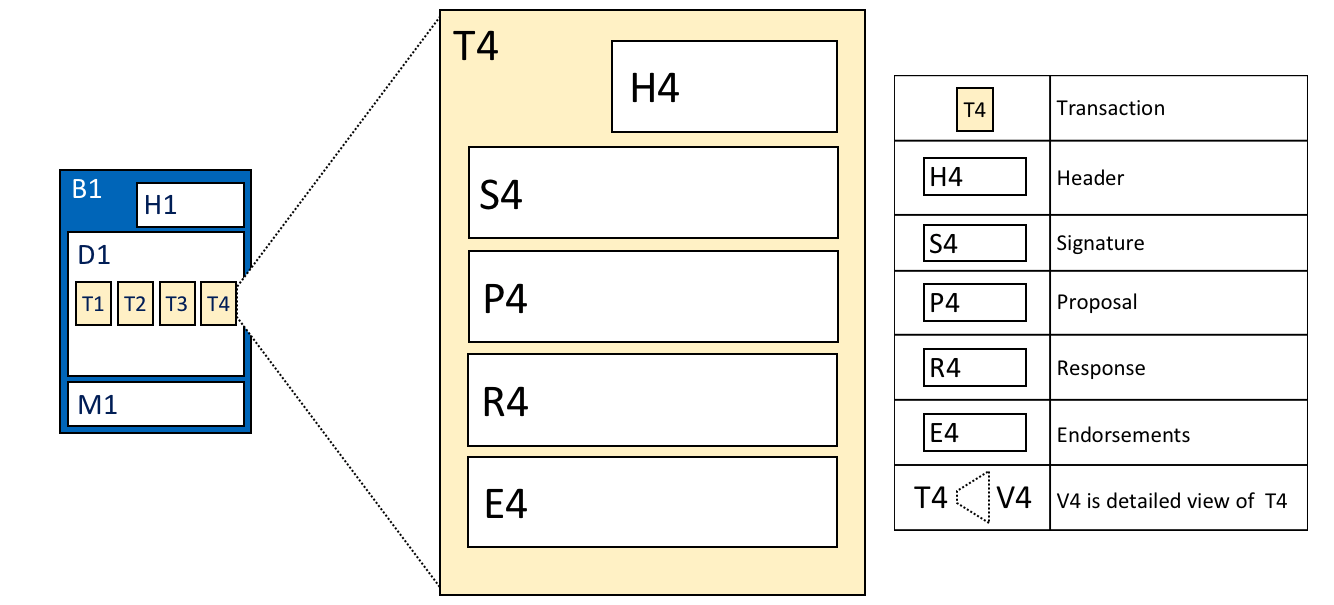 *Transaction details. Transaction 252 T4 in blockdata D1 of block B1 consists of transaction header, H4, a transaction 253 signature, S4, a transaction proposal P4, a transaction response, R4, and a list 254 of endorsements, E4.* 255 256 In the above example, we can see the following fields: 257 258 259 * **Header** 260 261 This section, illustrated by H4, captures some essential metadata about the 262 transaction -- for example, the name of the relevant chaincode, and its 263 version. 264 265 266 * **Signature** 267 268 This section, illustrated by S4, contains a cryptographic signature, created 269 by the client application. This field is used to check that the transaction 270 details have not been tampered with, as it requires the application's private 271 key to generate it. 272 273 274 * **Proposal** 275 276 This field, illustrated by P4, encodes the input parameters supplied by an 277 application to the smart contract which creates the proposed ledger update. 278 When the smart contract runs, this proposal provides a set of input 279 parameters, which, in combination with the current world state, determines the 280 new world state. 281 282 283 * **Response** 284 285 This section, illustrated by R4, captures the before and after values of the 286 world state, as a **Read Write set** (RW-set). It's the output of a smart 287 contract, and if the transaction is successfully validated, it will be applied 288 to the ledger to update the world state. 289 290 291 * **Endorsements** 292 293 As shown in E4, this is a list of signed transaction responses from each 294 required organization sufficient to satisfy the endorsement policy. You'll 295 notice that, whereas only one transaction response is included in the 296 transaction, there are multiple endorsements. That's because each endorsement 297 effectively encodes its organization's particular transaction response -- 298 meaning that there's no need to include any transaction response that doesn't 299 match sufficient endorsements as it will be rejected as invalid, and not 300 update the world state. 301 302 That concludes the major fields of the transaction -- there are others, but 303 these are the essential ones that you need to understand to have a solid 304 understanding of the ledger data structure. 305 306 ## World State database options 307 308 The world state is physically implemented as a database, to provide simple and 309 efficient storage and retrieval of ledger states. As we've seen, ledger states 310 can have simple or compound values, and to accommodate this, the world state 311 database implementation can vary, allowing these values to be efficiently 312 implemented. Options for the world state database currently include LevelDB and 313 CouchDB. 314 315 LevelDB is the default and is particularly appropriate when ledger states are 316 simple key-value pairs. A LevelDB database is co-located with the peer 317 node -- it is embedded within the same operating system process. 318 319 CouchDB is a particularly appropriate choice when ledger states are structured 320 as JSON documents because CouchDB supports the rich queries and update of richer 321 data types often found in business transactions. Implementation-wise, CouchDB 322 runs in a separate operating system process, but there is still a 1:1 relation 323 between a peer node and a CouchDB instance. All of this is invisible to a smart 324 contract. See [CouchDB as the StateDatabase](../couchdb_as_state_database.html) 325 for more information on CouchDB. 326 327 In LevelDB and CouchDB, we see an important aspect of Hyperledger Fabric -- it 328 is *pluggable*. The world state database could be a relational data store, or a 329 graph store, or a temporal database. This provides great flexibility in the 330 types of ledger states that can be efficiently accessed, allowing Hyperledger 331 Fabric to address many different types of problems. 332 333 ## Example Ledger: fabcar 334 335 As we end this topic on the ledger, let's have a look at a sample ledger. If 336 you've run the [fabcar sample application](../write_first_app.html), then you've 337 created this ledger. 338 339 The fabcar sample app creates a set of 10 cars each with a unique identity; a 340 different color, make, model and owner. Here's what the ledger looks like after 341 the first four cars have been created. 342 343 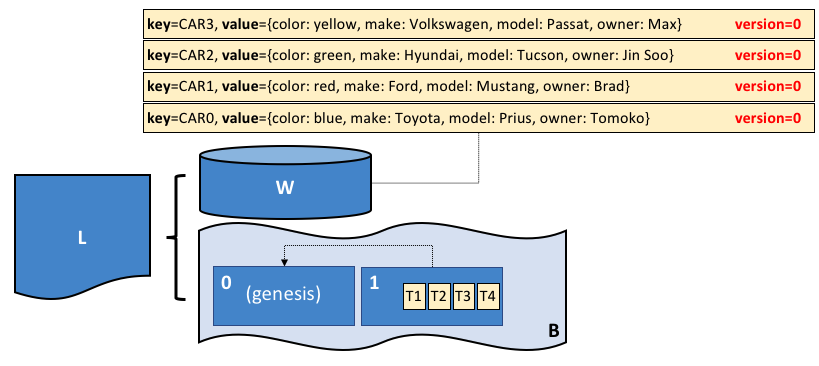 *The ledger, L, comprises a world 344 state, W and a blockchain, B. W contains four states with keys: CAR0, CAR1, CAR2 345 and CAR3. B contains two blocks, 0 and 1. Block 1 contains four transactions: 346 T1, T2, T3, T4.* 347 348 We can see that the world state contains states that correspond to CAR0, CAR1, 349 CAR2 and CAR3. CAR0 has a value which indicates that it is a blue Toyota Prius, 350 currently owned by Tomoko, and we can see similar states and values for the 351 other cars. Moreover, we can see that all car states are at version number 0, 352 indicating that this is their starting version number -- they have not been 353 updated since they were created. 354 355 We can also see that the blockchain contains two blocks. Block 0 is the genesis 356 block, though it does not contain any transactions that relate to cars. Block 1 357 however, contains transactions T1, T2, T3, T4 and these correspond to 358 transactions that created the initial states for CAR0 to CAR3 in the world 359 state. We can see that block 1 is linked to block 0. 360 361 We have not shown the other fields in the blocks or transactions, specifically 362 headers and hashes. If you're interested in the precise details of these, you 363 will find a dedicated reference topic elsewhere in the documentation. It gives 364 you a fully worked example of an entire block with its transactions in glorious 365 detail -- but for now, you have achieved a solid conceptual understanding of a 366 Hyperledger Fabric ledger. Well done! 367 368 ## Namespaces 369 370 Even though we have presented the ledger as though it were a single world state 371 and single blockchain, that's a little bit of an over-simplification. In 372 reality, each chaincode has its own world state that is separate from all other 373 chaincodes. World states are in a namespace so that only smart contracts within 374 the same chaincode can access a given namespace. 375 376 A blockchain is not namespaced. It contains transactions from many different 377 smart contract namespaces. You can read more about chaincode namespaces in this 378 [topic](./developapps/chaincodenamespace.html). 379 380 Let's now look at how the concept of a namespace is applied within a Hyperledger 381 Fabric channel. 382 383 ## Channels 384 385 In Hyperledger Fabric, each [channel](../channels.html) has a completely 386 separate ledger. This means a completely separate blockchain, and completely 387 separate world states, including namespaces. It is possible for applications and 388 smart contracts to communicate between channels so that ledger information can 389 be accessed between them. 390 391 You can read more about how ledgers work with channels in this 392 [topic](./developapps/chaincodenamespace.html#channel). 393 394 395 ## More information 396 397 See the [Transaction Flow](../txflow.html), 398 [Read-Write set semantics](../readwrite.html) and 399 [CouchDB as the StateDatabase](../couchdb_as_state_database.html) topics for a 400 deeper dive on transaction flow, concurrency control, and the world state 401 database. 402 403 <!--- Licensed under Creative Commons Attribution 4.0 International License 404 https://creativecommons.org/licenses/by/4.0/ -->